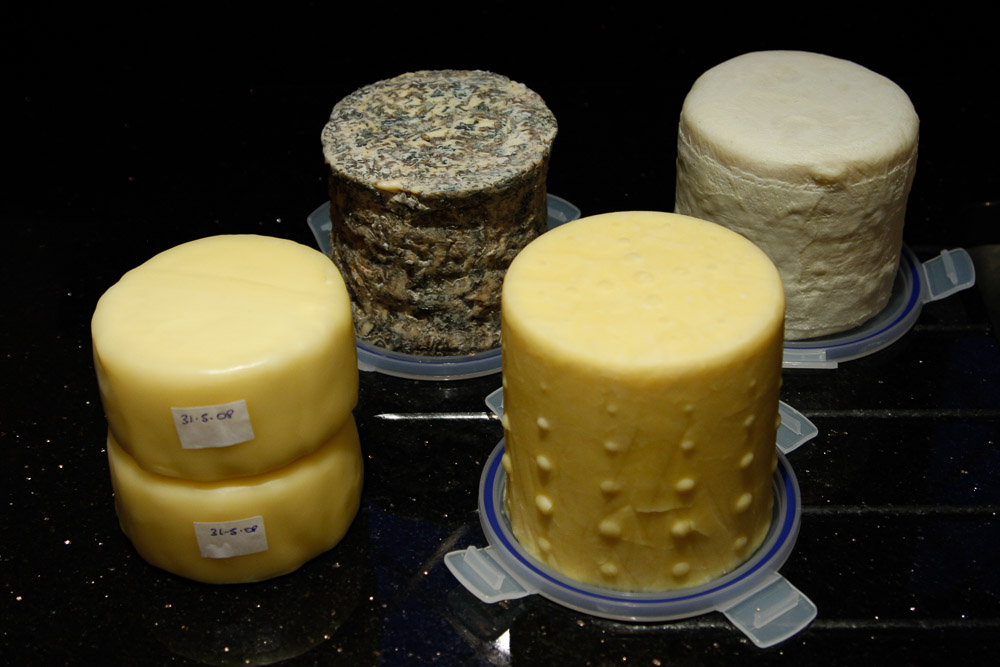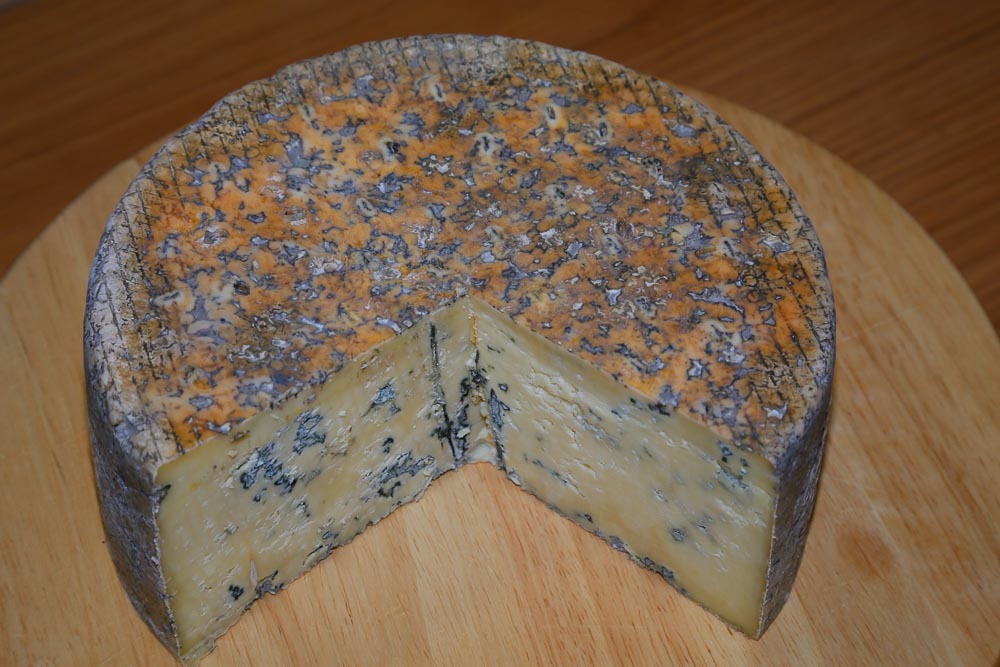Here are two recipes which I have successfully followed and made. My intention here is to give an overview of the cheese making process so you can decide if it is something you would like to do. If you want to make these cheeses I suggest you buy a book and or look at the original source of the recipe.
Blue Cheese
A Stilton style blue cheese. Recipe from Cheesemaking.com where you will find more detail than I have given here.
Ingredients
- 4 Gallons Whole milk pasteurised, non-homogenised
- Mesophilic starter culture
- 1 small pot Fage Greek yoghurt
- Penicilium roquefortii mould
- Rennet
Instructions
- Heat the milk to 32°C and add the culture and mould according to your particular brand instructions. Add the yoghurt and stir well.
- Maintain 32°c and leave to stand for 1 hour
- Add the rennet according to the instructions for your brand.
- Leave to stand for 30 minutes until a "clean break" is achieved i.e. when the curds break away when pressed with the back of a finger leaving straw coloured whey to fill the gap. It may take longer than 30 minutes.
- Gently cut the curds into 1" cubes and then stir gently for 5 minutes before letting them rest for 15 minutes. During the rest give a brief gentle stir every 3-5 minutes to prevent the curds from matting together.
- At the end of the rest remove about 3-4 pints of whey with a jug gently pressed into the surface of the curds and whey. Repeat the 15 minute resting and stirring. The curds will shrink during this time releasing more whey. Maintain the temperature at 32°C.
- Transfer the curds to a large mould lined with cheese cloth and allow them to drain for several minutes. Pulling up the cloth will aid the drainage.
- Now pack the curds gently into the final mould without any cheese cloth. I only have one large mould and so I transfer the curds to a small bucket between draining and packing. The curds around the bottom and sides of the mould can be pressed into place but those in the centre should be left loose as they fall; this ensures that there are air pockets in the centre of the cheese to allow the blue mould to grow.
- Once packed into the mould maintain the temperature at 32°C in the mould for another 4 hours. I do this by placing the mould back inside the double boiler but standing on the small bucket lifting the mould out of the water. Place a board on the mould and turn it 5 minutes after filling and then frequently during the 4 hour period.
- Leave overnight at room temperature in the mould. The next morning the cheese should be consolidated enough to remove it from the mould and salt it. This cheese is dry salted on the outside. This means adding the salt at about 2-2.5% of the cheese's weight to the outside surfaces over a period of 4 days. For my 4 gallon cheese, the finished cheese weighed 2.4Kg and I added 50g (2.1%) of salt divided into 4 doses.
- Mature the cheese at 11 – 12°C and 93-95% RH for about 90 days. After a couple of weeks poke holes in the cheese with a skewer about a couple of inches apart.
- I like to wipe the surface occasionally to keep the mould under control. I do this with a piece of cheese cloth moistened in salty water. Be careful not to close up the holes.
- Eat.
Gouda style cheese
This makes a good cooking / melting cheese. This is based on a recipe from Home Cheese Making by Rikki Carroll who is the founder / author of cheesemaking.com.
Ingredients
- 4 Gallons Whole milk pasteurised, non-homogenised
- Mesophilic starter culture
- Rennet
- 1 Kg Salt To make 5l brine
Instructions
- Heat the milk to 32°C, add the starter culture and stir well. Allow to ripen for 10 minutes.
- Add the rennet. Stir for one minute and let set at 32°C for 1 hour or until a clean break is achieved (see Blue cheese recipe)
- Cut the curd into ½ inch cubes and let set for 10 minutes. With a jug, remove about ⅓ of the whey and replace it with enough water at 80°C to raise the temperature of the curds to 33°C whilst stirring.
- Let the curds settle for 10 minutes and then remove whey down to the level of the curds. Again, stirring continuously, slowly add water at 80°C to raise the temperature of the curds to 38°C. Maintain the curds at this temperature for 15 minutes, stirring often to stop them from matting.
- Allow the curds to set for 30 minutes then remove the curds to a cheese cloth lined mould and press at 9Kg for 20 minutes.
- Repeat the above but press at 22Kg overnight.
- Remove the cheese from the press and float it in a saturated brine solution in a small bucket for 12 hours. The cheese will float above the surface, so also sprinkle some salt to cover the top surface.
- Remove from the brine and pat dry and allow to dry for a day or so. I then vacuum pack the cheese whilst it matures, occasionally removing from the pack and drying any liquid that it produces. The vac packing prevents any moild growth and stops the cheese from drying out. The recipe says to mature for 3-4 months or longer.
- Eat.

